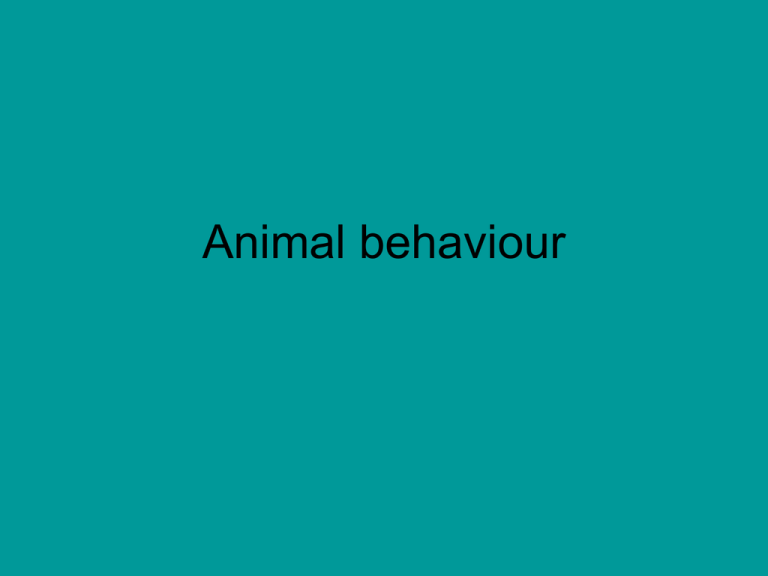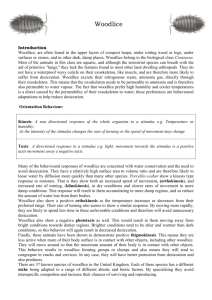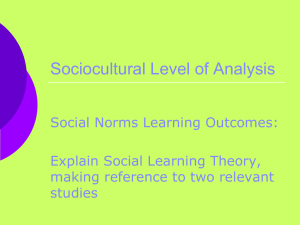Activity 5 Behaviours
advertisement

Animal behaviour Homework 2 – Monday Learning Intentions • I can give an example of an animal which respond to stimuli and give an explanation for the behaviour. Success Criteria • I can explain, with the aid of examples, the difference between instinctive behaviour and learned behaviours. • I can describe how an animal responds to a stimulus and give an explanation for the behaviour. Responding to the Environment What environmental factors would affect the behaviour of animals? Light, temperature, humidity Woodlice They eat leaves and so are Herbivores Choice chambers We need to design an experiment using a choice chamber that will tell us what conditions the woodlice prefer to live in. Experiment When several woodlice are inserted into a choice chamber they more around randomly. You can place one in the light and one in a dark environment to investigate what conditions they prefer. Experimental Report Title Aim Hypothesis Method (including diagram) Results table and graph Conclusion Evaluation Time (min) 1 2 3 4 5 6 7 8 Number of Woodlice (i) What is the advantage to the woodlice of gathering on the dark side of the choice chamber? •Woodlice are less likely to be spotted by predators. •Dark area more likely to be damper to prevent drying out . ii) Describe how the choice chamber could be changed to study the response of woodlice to two different levels of humidity instead of different light intensities. Remove the black cover. Add silica gel/drying agent to one half of the choice chamber and wet cotton wool/paper towels to the other side Animal Stimulus Woodlice Moisture Woodlice Light Blowfly maggots Light Paramecium Weak acid Response Importance to Animal Move to moisture In dry conditions, they loose water through their permeable skins and die Move away Protection- less easily seen by predators in dark from light Animal Stimulus Response Importance to Animal Move away Protection- less easily seen by predators in dark Woodlice Moisture Woodlice Light Blowfly maggots Light Paramecium Weak acid from light Animal Stimulus Response Importance to Animal Woodlice Moisture Woodlice Light Blowfly maggots Light Paramecium Weak acid Move to weak acid More chance of finding food-they feed on bacteria which live in slightly acidic water When do Fiddler crabs emerge from burrow to forage (low or high tide)? Emerge from burrow at low tide to forage What is the external trigger stimulus? What is the significance of this behaviour? Description of External Type of rhythmical trigger rhythm Animal behaviour stimulus Tidaloccurs at the turn of the tide Fiddler crab Crab hunts for food when tide is out Tide is influenced by the moon Significance Less chance of being eaten by a fish when tide is out When does an owl hunt? What is the external trigger stimulus? What is the significance of this behaviour? Description of External Type of rhythmical trigger rhythm Animal behaviour stimulus Circadian -every 24 hours Owl Hunts at night Onset of darkness Significance Owl has a better chance of killing prey When does a hedgehog hibernate? What is the external trigger stimulus? What is the significance of this behaviour? Description of External Type of rhythmical trigger rhythm Animal behaviour stimulus Annual – Hedgehog Hibernates in autumn once a year Shorter daylengths Significance Hedgehog can survive winter When does a swallow migrate from the UK? What is the external trigger stimulus? What is the significance of this behaviour? Description of External Type of rhythmical trigger rhythm Animal behaviour stimulus Annual – Swallow once a year Migrates to warmer climate in autumn Shorter daylengths Significance Better chance of finding food in warmer climate Behaviour that is repeated regularly Apparatus used to find out whether woodlice prefer light or dark, dry or humid conditions Woodlice move away from this so that they are not seen by predators Type of behaviour practiced by fiddler crab- comes out of burrow when tide is out Type of behaviour practiced by hedgehogs when they hibernate Type of behaviour practiced by owl when they start hunting at night Blowfly maggots move away from this to avoid being seen by predators Woodlice move to this because their skin is very permeable and prone to drying out Rhythmical behaviour Behaviour that is repeated regularly Choice chamber Apparatus used to find out whether woodlice prefer light or dark, dry or humid conditions Light Woodlice move away from this so that they are not seen by predators Tidal rhythm Type of behaviour practiced by fiddler crab- comes out of burrow when tide is out Annual rhythm Type of behaviour practiced by hedgehogs when they hibernate Circadian rhythm Type of behaviour practiced by owl when they start hunting at night Light Blowfly maggots move away from this to avoid being seen by predators Moisture Woodlice move to this because their skin is very permeable and prone to drying out









